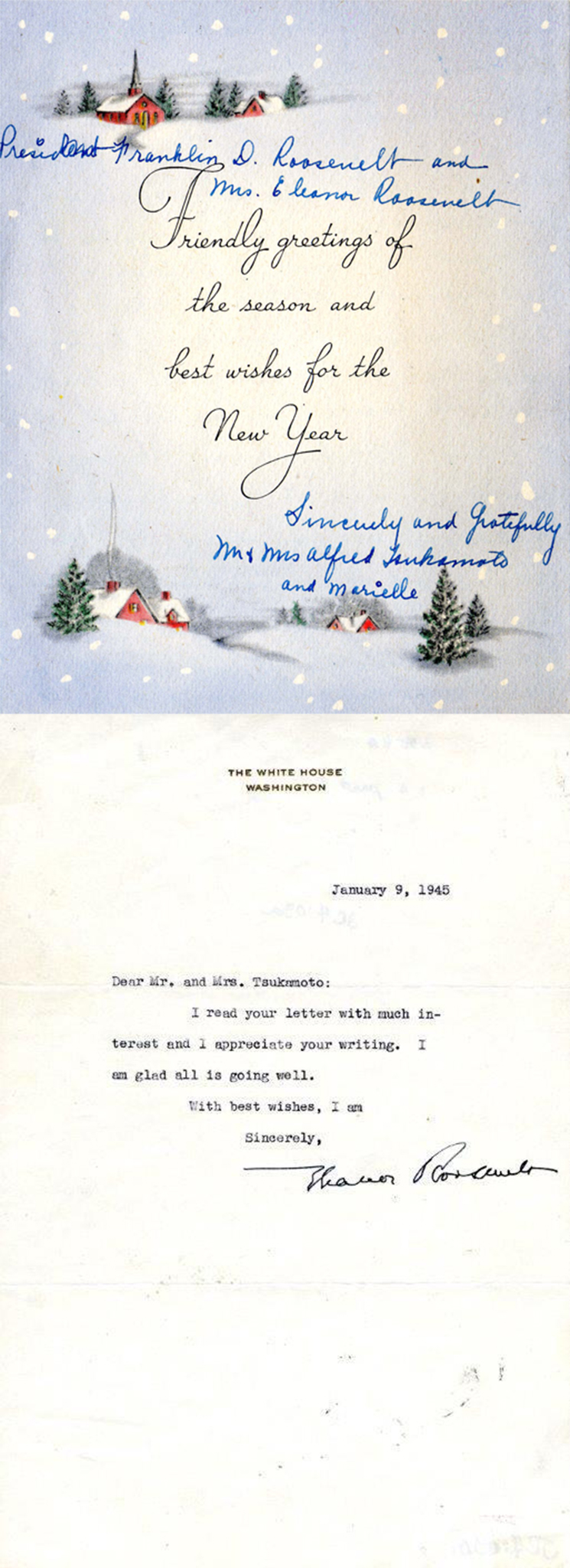
In December 1944, Mary Tsukamoto sent a Christmas card and letter to President Franklin and Eleanor Roosevelt from the internment camp at Jerome, Ark., where she, her family and other Americans of Japanese descent were held during World War II. Eleanor Roosevelt’s brief reply arrived the following month.
Sacramento State’s Japanese American Archival Collection (JAAC) is the largest holding of its kind in the California State University system. For that reason, Sac State will receive $40,000 – the largest share of a $321,000 National Park Service grant awarded to a consortium of 13 CSU campuses – to digitize original documents related to the World War II internment of Japanese-born and Japanese American citizens.
Planning for the two-year CSU Japanese American Digitization Project will begin in September. Eventually, more than 10,000 unique, historic documents belonging to the 13 universities will be made available worldwide to scholars, researchers, schoolchildren, filmmakers, and others on a CSU-sponsored website.
Sac State’s $40,000 grant share will allow the Department of Special Collections and University Archives to hire student library assistants to digitize about 4,000 historic paper items, including the personal correspondence of Sacramento internees forced from their homes, farms, and businesses by the U.S. government.
“Some CSUs only have one box in their collection but it’s unique to their community,” says Julie Thomas, Sacramento State’s Special Collections and Manuscripts librarian. “What makes our collection special is the depth and breadth of the documentation. Ours is the best, hands down. These are primary sources that haven’t been interpreted or have a bias. It’s the unvarnished truth.”
Among the documents are personal letters and diaries, newsletters, yearbooks, War Relocation Authority publications, and newspapers from the period.
Sac State’s JAAC was created in 1994 with a gift of photographs, artifacts, and documents from longtime Sacramento teacher Mary Tsuroko Tsukamoto. She grew up in the Florin community, where her parents farmed grapes and strawberries. Before World War II, Florin was home to hundreds of Japanese immigrants and their American-born children.
Tsukamoto spent the war years with her husband and daughter in the internment camp at Jerome, Ark.
Two months after Japan attacked American military installations at Pearl Harbor, President Franklin Roosevelt signed Executive Order 9066, which sent about 120,000 Americans of Japanese descent to 10 internment camps around the country. There they stayed until the war’s end.
According to the National Archives, 5,121 people gave Sacramento as their last permanent address before evacuation.
Tsukamoto encouraged others in the Japanese American community to donate their internment-related memorabilia to Sacramento State. VFW Nisei Post 8985 gave its records, the Florin Japanese American Citizens League gave its oral histories, and many families offered photographs and artifacts.
The University Library staff hopes that the CSU Japanese American Digitization Project will prompt more donations to the JAAC.
“We want to add to the collection and share it with our students and the world,” says Amy Kautzman, dean of the library. “By sharing the hard reality of the internment camps, we can help ensure that this won’t happen again.”
More than 1,300 donated photographs and artifacts (including furniture, clothing, farm implements, and arts and crafts) were digitally reproduced in 2004 and can be viewed at the JAAC ImageBase: http://digital.lib.csus.edu/jaac.
“The documents were the glaring gap in the ImageBase, because of the challenges of digitizing them,” says Thomas.
The library now owns a special scanner with a book edge meant to reproduce fragile printed material.
“In telling the story of Japanese American internment, the manuscripts – more than the photographs and artifacts – provide the legal and personal details,” says Jennifer Ware, interim associate dean of University Library. “They fill in the spaces. We’re fortunate that the Florin community saved these documents and worked with Sac State to donate them, so that we can make them available to researchers.”
Sacramento State’s collection is the most comprehensive in the CSU, Thomas says. “It tells all sides of the story. You get the point of view of evacuees, internees, the government, people who supported the evacuation, and people who protested it,” she says. “That’s what makes our collection so special. There always are two sides to a story, but in this case, there are about five. A good researcher might want to look at it from all of those angles.”
Planning for the two-year CSU Japanese American Digitization Project began in 2014, when Sacramento State and four other CSUs shared a $40,000 grant from the National Endowment for the Humanities. The larger consortium was awarded the $321,000 National Park Service grant earlier this summer.
In addition to Sacramento State, the CSU campuses participating in the digitization project are Dominguez Hills, Bakersfield, Channel Islands, Fresno, Fullerton, Northridge, San Jose, San Bernardino, San Diego, San Luis Obispo, San Francisco, and Sonoma. – Dixie Reid
In the media:
"Sacramento State to put history of Japanese internment online," The Sacramento Bee
"Sacramento State project aims to digitally preserve Japanese internment camp memories," CBS 13